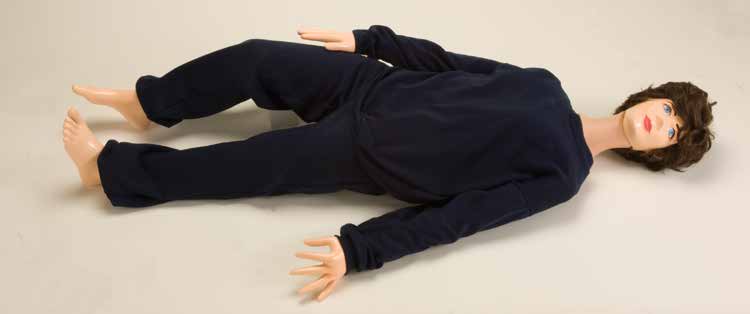Anthropomorphic Phantoms... Ideal Substitute Patients for Teaching/Training Radiologic Technologists
• Permit unlimited repetitions of most views…patients cannot be used for this…
• Demonstrate effects of changing technical factors…
• Provide valid feedback to evaluate trainee performance…
• Because the same phantom can be used year after year, performance norms can be derived to guide training procedures…
Human Skeletal Architecture Is Duplicated More Realistically with Capintec Skeletons Than With Cadaveric Skeletons
Soft-tissue molds and skeleton molds are matched for anatomic fidelity.
The skeletons meet radiation interaction properties of both cortical bone and spongiosa as standardized by the International Commission on Radiation Units and Measurements. Many cadaveric human skeletons do not… especially when dried out for their preparation.
PIXY THE ANTHROPOMORPHIC TRAINING/TEACHING PHANTOM

Pixy... Opaque Phantom
• An anatomically and radiologically correct female
• Small size and low weight simplify positioning
• Permits evaluation of student performance
• Organs accept contrast media
• Opaque or transparent
PIXY was designed specifically for training radiologic technologists. PIXY is 5 ft. 1 in. (156cm) tall and weighs 105 lbs (48kg). She is repeatable, virtually indestructible, and a convenient substitute for patients.
PIXY is made of tissue-equivalent materials and has life-like articulations. Students have no difficulty in maneuvering PIXY into most desired positions.
PIXY is used to demonstrate anatomy and evaluate positioning and imaging techniques, including kVp, mAs, contrast, optical density, OFD and TFD. Radiographs of PIXY are optically equivalent in density and contrast to human patients.
PIXY permits unlimited exposures and tolerates trainee errors.

Pixy... Transparent Phantom
PIXY Anatomy
PIXY shoulders have ball and socket joints, elbows and knees flex 90° to 100°. Hips flex 130° with 30° hyperextension.
A “frog position” is made possible by lateral flexion at the hips. The right hand is molded with fingers positioned for an AP view, while the left hand is in an oblique-lateral position. The left foot is in full plantarflexion, the right foot is in a neutral position.
C1, C2, C6 and C7 were converted to mechanical nylon joints because educators in the field prefer full positioning capabilities for the head. The design permits the remaining neck vertebrae to be fixed in a normal position, while assuring a full range of head motion.
PIXY contains abdominal and pelvic organs: stomach, gall bladder, urinary bladder, kidneys, rectum and sigmoid flexure. These are air-filled, but accept water or contrast media and can be easily flushed after use. Custom fractures and custom pathologies are optional.
PIXY Materials
Skeletons- Skeletons are in continuous production, so prompt shipments are routine. Nevertheless, human skeletons are available for users who desire them. There is a surcharge to cover the high cost of scarce natural skeletons and for added labor needed to rework them to fit PIXY molds.
The matching of skeletons and soft-tissues permits external and bony landmarks to coincide. The position of bones within the soft tissues is anatomically correct.
The detail cast into skeletons is considered a triumph of the sculptural moldmaker’s craft. The skull, for example, has frontal and sphenoidal sinuses, ethmoidal and mastoid air cells and the auditory ossicles. Bone sutures are radiographically visible.
Soft Tissues- PIXY is available in opaque or transparent tissue-equivalent materials. The transparent PIXY has visible organs and skeleton except at the hips, knees and elbows, which are opaque because, as on the opaque PIXY, latex coverings are needed to retain tissue-equivalent gels for soft-tissue continuity at these articulations. Two-ply coverings protect against gel leakage.
Lungs- Standard PIXY lungs are molded of tissue-equivalent foam with the mass density of inflated human lungs (0.30 g/ cc). They are connected to the oro-nasal cavity by the stem bronchi and trachea. The oro-nasal pharynx is filled with a nearly air-equivalent foam.
Optional animal lungs, which duplicate the intricate detail of the vascular trees, are available. These lungs are fixed in the inflated state and molded to confirm to the pleural cavities of the phantom. The pulmonary arteries are injected with a blood-equivalent plastic. In addition, low, medium or high contrast material may be selected by the user.
Refurbishment- Capintec offers a PIXY refurbishment service which, after wear and tear from usage over an extended period of time, restores PIXY to its original condition. This service includes repair of minor bone fractures of hands and feet. Quotes are furnished upon request for more extensive damage.
ITEM NUMBERS
Pixy.................................................................................................... 0695-0001
Pixy- Transparent ............................................................................ 0695-0002
Actual Lungs .................................................................................... 0695-0003
Custom Fractures & Pathologies ................................................... 0695-0004
Standard Pixy Refurb...................................................................... 0695-0005

